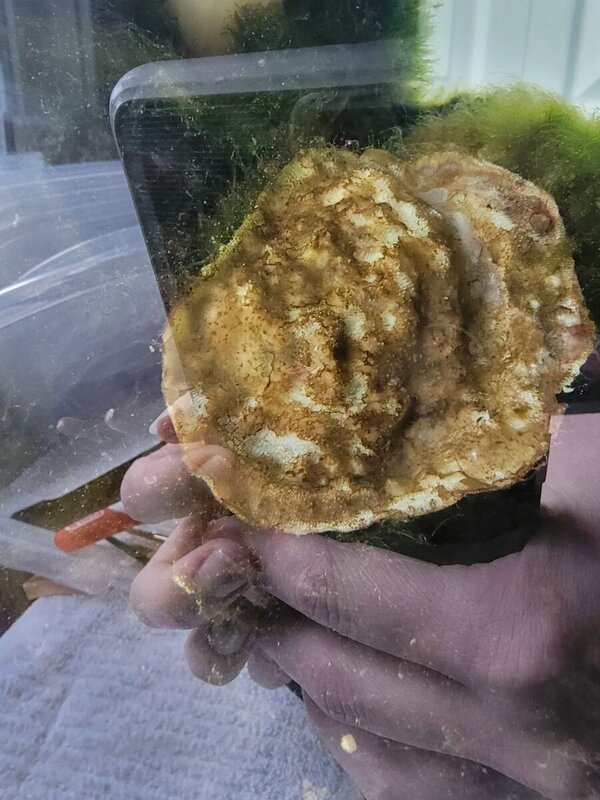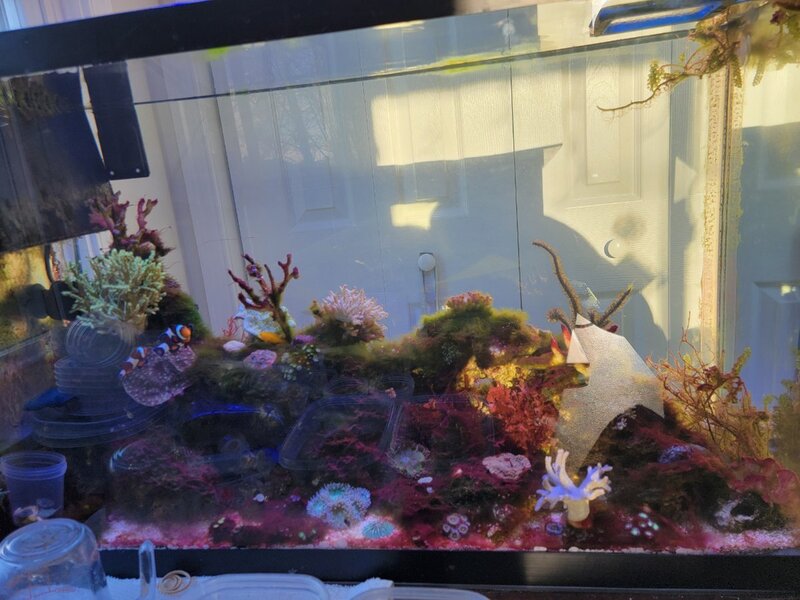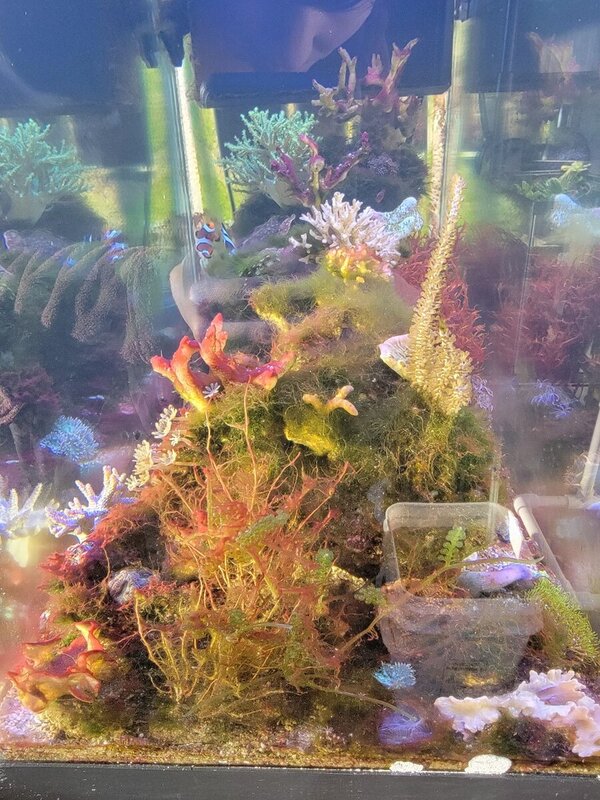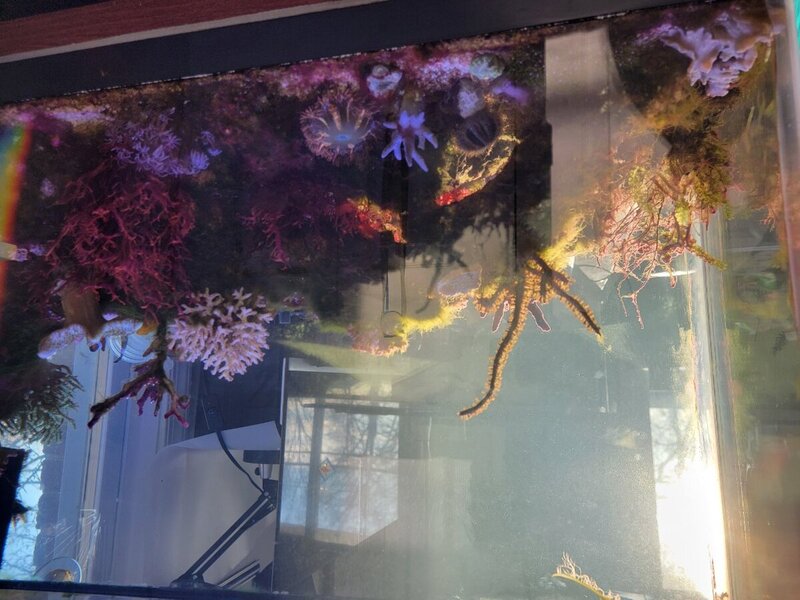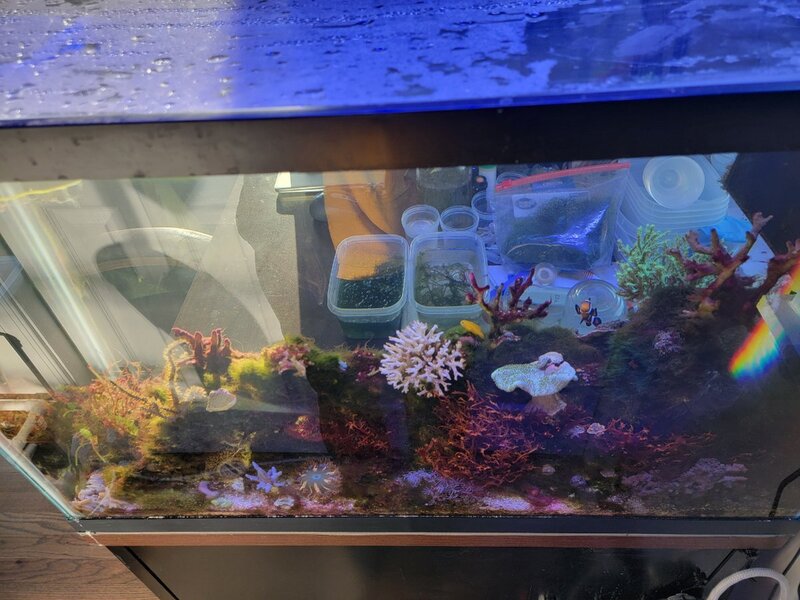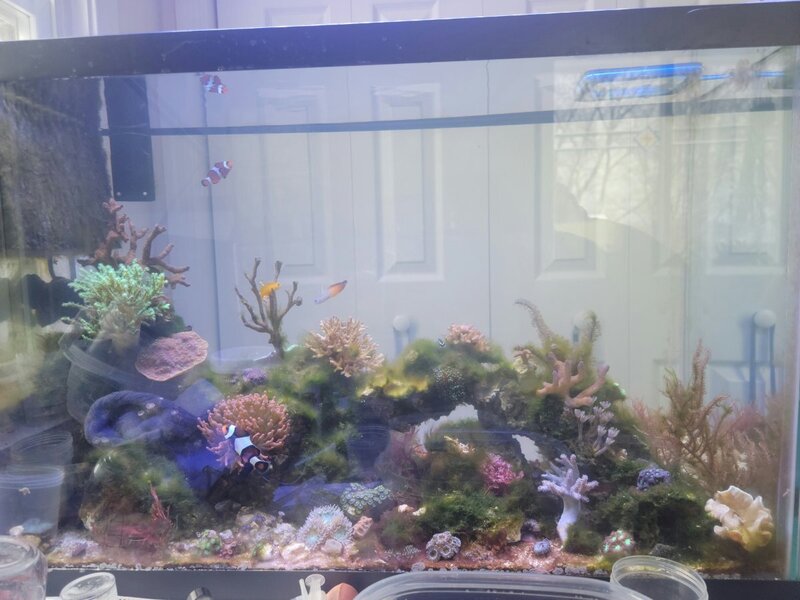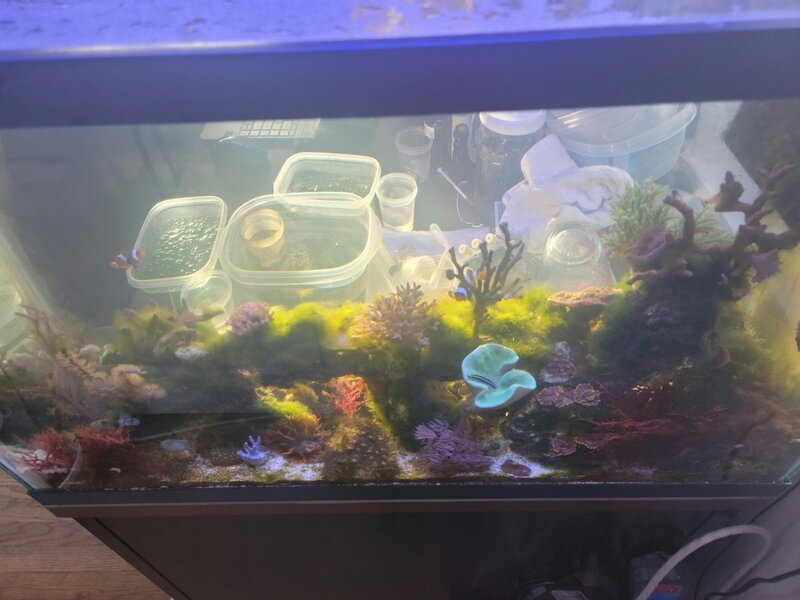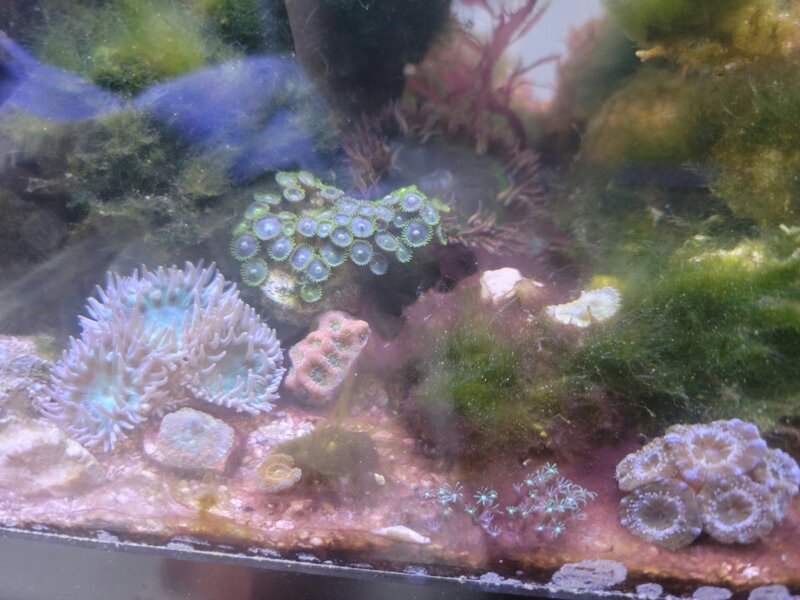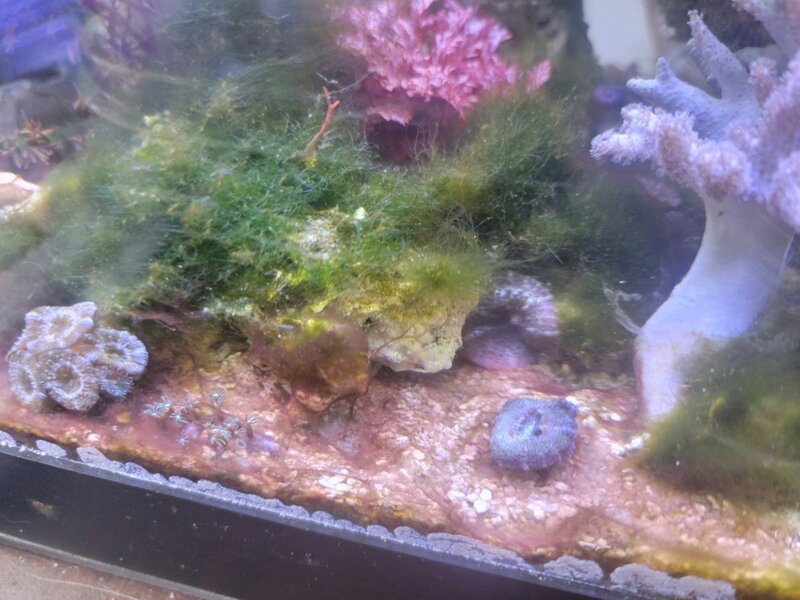
Kathryn Lawson
WAMAS Member-
Posts
141 -
Joined
-
Last visited
Content Type
Profiles
Forums
Gallery
Events
Store
Everything posted by Kathryn Lawson
-
Welcome! I'd suggest also joining PVAS, the Potomac Valley Aquarium Society, which focuses on freshwater. They have monthly meetings with small auctions, as well as two all-day auctions each year - a good way to rehome any extra fish!
-
Need advice - algae and cyno; nitrate 0, phosphate 0.3
Kathryn Lawson replied to Kathryn Lawson's topic in General Discussion
Hey folks, my ICP test results are back!! Results here: https://www.triton-lab.de/en/showroom/icp-oes/210778 Interestingly, just about everything is in a good range, with the notable exceptions of phosphorus (which we knew) and... tin. While it's possible it's a false positive, the level is high enough to seem relatively unlikely. A quick search has informed me that along with other standard heavy metal sources like malfunctioning equipment, tin can come from plasticizers in flexible tubing... I am using vinyl tubing for my drains and return line, and have gone through two sets because I had to increase the tubing size to decrease head pressure on my return pump and enable higher drainage rates to accommodate higher flow rates! Also, float glass is apparently made by pouring molten glass onto molten tin. If a manufacturer isn't careful to track which side was touching the tin, it can end up on the inside of the tank instead of the outside like normal. My tank is an Aqueon, so I wouldn't be terribly surprised if this was the case for my tank. As a bit of history, my system was running (totally fine) for 6+ months before moving into the current tank (started small and upgraded, and then had a leak). I also didn't use a sump (or flexible tubing) at all until this fall, which was right after I started having issues with algae growth (I'd previously used a simple HOB and added the sump so I could have a refugium and extra filtration). So both of these potential causes of tin didn't start out with my system, and might explain why things were going well for quite a while before taking a downturn. Also interesting is that SPS are particularly sensitive to tin. Before the tank crash that I've been associating with the major cyano bloom and alk swing, I was having some odd issues with SPS dying back. The alk swing was almost certainly from me starting to dose kalk in an attempt to help the struggling SPS. Looking into potential options for tin removal, it seems cuprisorb is often recommended, and luckily I actually even have some already (had for a freshwater tank that had been having issues with shrimp and I'd wanted to rule out heavy metals). I'm thinking I'll be adding some to my system today! -
REEFING USA Frag Swap Meet This Sunday!
Kathryn Lawson replied to Supreme Reefs's topic in Supreme Reefs
Is the show on both 3/23 and 3/24? Asking because your post says 3/23 and Saturday, but the flyer only says 3/24 (Sunday). -
Reef sounds encourage coral larvae to settle
Kathryn Lawson replied to Salty Rambler's topic in General Discussion
Super cool, thanks for sharing!! -
Need advice - algae and cyno; nitrate 0, phosphate 0.3
Kathryn Lawson replied to Kathryn Lawson's topic in General Discussion
A good update finally!!! Chemiclean seems to have taken care of almost all the cyano! My fish and inverts have thankfully been totally fine (my firefish seem pretty terrified of all the air bubbles, but they have made a few short appearances), and excitingly, every coral that remains alive has shown marked improvement, better than they have in weeks! Zoas are open, lobo has puffed back up some, leathers and pulsing sinularia are showing polyp extension, etc. The only one still struggling is my toadstool leather, which I now realize must have something other than cyano going on, and is still melting away as the red-brown patchy growths on its surface spread. Can softies get brown jelly or something like it? I'm going to try to see if I can cut a clean frag tomorrow, maybe dip the remainder in iodine. Given the remarkable improvement in coral health, I want to make sure the cyano is knocked back pretty hard for now. I left the first dose for 72 hours instead of 48 (since I still saw small amounts of cyano in the sand, overflow box, etc. at 48 hrs). Since I still see a few remaining traces of cyano tonight at the 72-hour mark (and thinking along the same line as how for human/animal health we use a longer course of antibiotics than needed to simply alleviate symptoms, to avoid development of resistant strains) I decided to run one more round of chemiclean, and added the dose tonight (second round as needed is recommended by Marc Levinson and some others). I'll let that go for 48, maybe 72 hours again, then do a big water change and add carbon to remove any remnants of the chemiclean. Nutrients are doing reasonably well, especially since I'd figured the chemiclean killing off the cyano would result in a nutrient spike, but it seems that it didn't release too much. Phosphates are up a bit but nitrates have reached the point where I absolutely need to start dosing now to avoid hitting 0 (also why I'm going with a second round of chemiclean, since nitrate dosing really stimulated cyano growth last time). Nitrate: 0.1 Phosphate: 0.22 Alk: 9.6 Calc: 411 Mag: 1120 Anyway, I'm so relieved that something finally seems to be going right! Now I just need to make sure I keep pushing things in the right direction and don't let the cyano rebound. I'm going to slightly increase the dose of Microbacter7 after the second round of chemiclean is done, and perhaps resume dosing of live phyto. Anything else I should consider? Should I start daily water changes again after chemiclean round 2 is done? Thanks for all the support, everyone - it's really been helpful to get feedback throughout this struggle! -
Need advice - algae and cyno; nitrate 0, phosphate 0.3
Kathryn Lawson replied to Kathryn Lawson's topic in General Discussion
For ICP, I tried to upgrade a free sample I had (free version is just 5 elements, mostly what I've already been measuring). The packaging indicates I can pay a bit and upgrade it to a full test but I can't seem to do it on the company's app or on their website. I sent a message to their customer service days ago with no response. Just ordered a kit from a different vendor. I saved a sample from before I added the chemiclean, so will probably use that. -
Need advice - algae and cyno; nitrate 0, phosphate 0.3
Kathryn Lawson replied to Kathryn Lawson's topic in General Discussion
Hey, everybody. I have switched over to Instant Ocean salt for the daily water changes now, and the tank move during window installation went surprisingly well. I decided to not stress about doing a major water change with everything else going on, so I just drained the tank down and filled it right back up again with the same water once moved. It's now back in its original spot, just with a new window right behind it. Unfortunately, over a week of H2O2 dosing hasn't seemed to have much of, if any, effect and coral health still keeps going downhill. Water quality parameters have improved somewhat, though nitrate is almost gone and I'll need to do something about that in the next few days. Current parameters: Nitrate 0.6 Phosphate 0.18 Alk 9.8 Calc 940 Mag 411 Given that the main part of my crash seemed to happen right around when I started trying to raise my nitrate levels in an unsuccessful attempt to counter the cyano, starting nitrate dosing again with everything but the cyano in even worse shape than before didn't seem like a good idea. I finally decided to use the cyano treatment option I'd been holding off on: following a major round of algae and cyano removal tonight, I dosed chemiclean. I don't seem to have nearly the tank diversity I had pre-algae/cyano, and I'm feeling perilously close to giving up on the whole tank. I have an extra air pump set up in the main tank with tons of small bubbles, and have an additional fine bubble air stone in the sump, along with my skimmer cup removed so the foam overflows back into the tank, and my tank drain line opened up so it gurgles and constantly pulls in air (annoying, but worth it for the extra aeration). I also added back in all the macroalgae I removed before starting H2O2 dosing, and removed the carbon in my sump to prevent premature removal of the chemiclean. I think I've done just about all I can do right now, though please let me know if there's anything I missed! Going to wait 48 hours, then do a 20% water change, add carbon, and put the skimmer cup back on. Here's hoping everything goes ok... -
Need advice - algae and cyno; nitrate 0, phosphate 0.3
Kathryn Lawson replied to Kathryn Lawson's topic in General Discussion
A question for you helpful folks: I'm going to have to temporarily move my reef tank on Wednesday for window installation. The current plan is to drain the display at least halfway and "slide" it over to the middle of my desk for the day (it's currently on the end of my metal-framed desk, in front of the window). The desk and the sump underneath can stay in place, thankfully! I'm picking up Instant Ocean salt tonight, and am wondering if this might be a good time to do one larger water change with the new salt to really boost calc and mag levels and drop phosphate, but also worry about shocking my system with the sudden change. Any idea what might be a safe amount of water to change out? My display is a 29 gallon tank, with a 10 gallon sump (but the sump is not filled all the way - there's some extra space even when the return pump is off and the pipes have drained). My current daily change volume is 3 gallons. I actually have an empty spare 29 gallon tank, so I technically could do even a 100% water change. (I learned when my first 29 gallon sprung a leak a few months in that I always want to have a backup option to hold all the tank contents!) -
Need advice - algae and cyno; nitrate 0, phosphate 0.3
Kathryn Lawson replied to Kathryn Lawson's topic in General Discussion
Thanks everyone! My nutrients are definitely headed in the right direction now, though I think I'm probably going to have to start dosing nitrate tomorrow. Parameters after tonight's water change and cyano/algae removal are: Nitrate 3.0 Phosphate 0.22 Alk 10.8 Calc 405 Mag 1020 Calc and mag are still low, but I haven't switched salt yet (partner was going to get some while running errands near Petco today but the store was closed by the time they got there, so I'll probably go myself tomorrow). Aesthetically, I do like having sand in my aquarium, and more importantly, my next planned livestock addition has been a pistol shrimp and goby pair (obviously now I'm going to wait until my system is stable), so I do really want to keep some sand. That said, there is a lot of detritus building up in corners and low-flow zones, which I doubt is helping the nutrient situation. I had a bunch of frags on the sand also, further hindering flow. I moved them up onto the rocks tonight, and plan to stir up/siphon a bit of the sand bed every other day or so during the water change. Hopefully that will let me get the junk out while minimizing nutrient spikes and overall disturbance of sand bed life. Regarding cleanup crew, I've had a really tough time getting snails. Earlier in the thread I described specifically picking out 5 actively-climbing snails (3 trochus, 2 turbo) from a reputable local store, but once in my tank they would extend from their shells but seemed unable to grab onto a surface or climb. This lasted for a number of days (I tried a number of different surfaces, etc) until they eventually died and further spiked my nutrient levels. I'd had the same thing happen in the past, getting an active snail from a different reputable local store, and once in my tank it would extend from the shell but not actually grab anything. I know @ReefdUp said not to worry too much about CC losses, but this pattern of immediate incapacitation with originally active snails seems very suspicious to me. I was talking about this with folks at the last WAMAS meeting and I think it was @nburg who mentioned he'd seen similar behavior followed by death when moving a snail he'd had for a while from a tank with low phosphate to a tank with high phosphate. I didn't drip acclimate the snails (I'm coming from freshwater where snails are practically as hardy as rocks, so although I'm used to using drip acclimation for shrimp, it didn't occur to me to do it for snails), so I think I'll try some snails again once my phosphates are lower (sub 0.1?) with drip acclimation this time. For other CUC, my remaining tuxedo urchin (had 1 rock boring and 2 tuxedo initially, but the rock boring one died at the same time as those 5 big snails, and I haven't seen the other tuxedo since then) has been doing a really good job clearing even the really strongly "rooted" algae from the areas it covers. So once the tank is stable for a while, I'll probably get a few more tuxedo urchins as well, along with hermits and snails, and ideally some money cowries. -
Need advice - algae and cyno; nitrate 0, phosphate 0.3
Kathryn Lawson replied to Kathryn Lawson's topic in General Discussion
Last night (Tuesday) I spent 4 hours siphoning cyano (and algae) and trying to clean it off of corals. This is after I spent multiple hours on Saturday siphoning out all I could get then. I feel like I'm fighting a losing battle against cyano - it's growing back so fast, and my livestock health just keeps going downhill. My bubble tip nem was fully detached and shriveled up on the sand bed, my Kenya tree completely dissolved into goo (ended up removing it entirely), and cyano grew on my toadstool leather since Saturday (update, regrew overnight also), worsening the erosion of flesh that started with previous cyano growth on it. Flesh has entirely peeled off the chalice and bowerbanki I got recently from @ReefdUp, and I've also lost multiple heads of a blasto that got covered in cyano between Saturday and now. On top of everything, my pump seems to be having issues, whining really loudly and changing flow rates around which makes my overflow gurgle really annoyingly (and yes, I cleaned the pump). Not going to go into this issue here, but it is a resurgence of a previous problem I thought I'd resolved, so I was feeling extra frustrated Tues night. I know that when things go wrong in a reef tank it's really easy to overreact, change too many things all at once, and totally crash the system. But I also don't think the livestock in my system is going to last much longer unless I do something other than the daily water changes. I typed most of the above text last night (Tuesday), but decided to hold off on posting and see how much cyano grew back in a single day. A surprising amount of cyano grew back just over the course of 24 hours (and livestock health further declined), enough that I decided I really did need to do something about it other than just repeated siphoning. Current tank parameters (Wed night before daily water change. Haven't switched salt yet so calc/mag are still low. I plan to buy some new salt this week): Nitrate 7.4 Phosphate 0.29 Alk 10.7 Calc 382 Mag 940 In reading about cyano in the reef aquarium, it seems that there's actually multiple microbes that have similar growth and are commonly labeled "cyano". Cyano is sensitive to H2O2 but sometimes not ChemiClean, and spirulina is not sensitive to H2O2 but will be killed by ChemiClean. I tested and the cyano in my system seems to be sensitive to H2O2, so I'm going to start there. Recommended dosing is 1ml of standard pharmacy 3% H2O2 per 10 gallons of saltwater, every 12 hours. Few side effects have been reported other than slightly negative impacts on algae, including desirable macroalgae (so I pulled mine and am keeping in a separate container for now), and possible sensitivity with Lysmata shrimp (which I don't have). So I added the first 4ml dose tonight, right into an area of high flow, and will see how things go! Since phosphate is so much higher than nitrate, I also decided to add two small cubes of "phosphate removing media" that I'd gotten for free a while back. I don't want to drop phosphate too fast, and I certainly don't want to bottom it out, but I do want to get it lowering slightly faster than it is currently, especially since my nitrate is now right about where I want it. I'll keep monitoring closely. One final update - I finally set up automated phyto dosing with a lit, aerated setup next to my sump! I've been culturing it elsewhere in my house for a while now, but kept using it to culture pods, and continually forgot to actually bring it upstairs and dose my tank! I know the H2O2 dosing may counteract the phyto dosing in the short term, but I'm timing the doses to have minimal overlap, and more importantly, now it's in place end ready to keep going once I'm done with H2O2 dosing. Sorry for such a long update, and sorry for going against some of your advice to wait it out! I'm hoping my decisions make some amount of sense, especially in light of my struggling livestock. If it was just an aesthetic issue, I'd happily wait it out, but I don't think I have the time for that in this case. -
Need advice - algae and cyno; nitrate 0, phosphate 0.3
Kathryn Lawson replied to Kathryn Lawson's topic in General Discussion
The main reason I'm considering IO over RC is that RC has more elevated alk, calc, and mag. I've read a number of forum posts with people commenting that they prefer IO because they don't have to worry as much about alk etc. swings when doing water changes like they experienced with RC. Yes, my skimmer has been on and skimming very wet - I've been dumping it when doing the daily water change. I wasn't able to measure phos every day last week - the measurements I have are 0.48 on 2/23 (at the end of the blackout, before starting daily water changes), 0.37 on 2/28, and 0.31 on 3/3. (Nitrate levels for those dates were 16.7, 12.4, and 10.8, respectively). So definitely heading in the right direction, at least! I just hope my struggling corals can hold out long enough to get nutrients balanced and cyano controlled -
Need advice - algae and cyno; nitrate 0, phosphate 0.3
Kathryn Lawson replied to Kathryn Lawson's topic in General Discussion
The salt I've been using is Crystal Sea Marinemix, Bioassay formula. Mixes up as Nitrate 0 Phosphate 0.02 (was from RODI, but replaced filters last night so should be addressed now) Alk 10.0 Calcium 388 Mag 940 It looks like this salt is low in calcium and magnesium compared to what is desirable. Since I've been using this salt for a year now, I'm not inclined to think this is the direct cause of the sudden/major issues I've been dealing with, though it is quite probably an underlying factor destabilizing coral health. I'm thinking I'll use up my current salt with these daily water changes, then once those are done (or sooner if I run out of salt), switch (probably more slowly than with daily changes, to avoid shock?) to a different salt - perhaps regular Instant Ocean (not reef crystals). Does this sound good, or should I consider an alternative salt or doing the switch during the daily changes? An ICP test isn't a bad idea. Any recommendations for brand, likely prioritizing response time? I'm also wondering about careful use of a phosphate reducer to help balance my nutrients slightly faster than water changes/biological growth can do alone, now that nitrates are right around where we want them. Thoughts? -
Need advice - algae and cyno; nitrate 0, phosphate 0.3
Kathryn Lawson replied to Kathryn Lawson's topic in General Discussion
Hi all. After a bit over a week of daily water changes (3 gallons a day on my 29+maybe 6 gallon system), my parameters are: Nitrate 10.8 Phosphate 0.31 Alk 10.8 Calc 389 Mag 980 Cyano is still super thriving and corals are still looking pretty unhappy (as is my bubbletip nem, which is super shrunken to the point of almost being unrecognizable, and moving around). Even my softies are looking bad - among other things, some mushrooms have had their mesenterial filaments spilling out their mouths pretty much all the time, and a Kenya tree looks like part of it is dissolving into goo. Some of the corals that had been seemingly stable during the previous weeks have had cyano on them this past week and are now showing tissue loss/recession, so I'm getting pretty worried about the cyano, which I think is probably my main issue right now (I know my water parameters aren't great, but they also don't seem bad enough to match the impact I'm seeing on my corals). I have heard some pretty good things about using coral snow (calcium carbonate) as a flocculent and to help against cyano, though it seems to be more recommended for prevention or light cases of cyano (which mine certainly isn't - the whole tank was covered in red before I siphoned it for multiple hours yesterday). Anyone have experience using coral snow for bigger cyano problems? Besides considering coral snow, I'm feeling pretty close to pulling the trigger on using chemiclean, with the plan to siphon out the cyano I can beforehand, remove carbon, remove the skimmer cup, and add air stones in the tank during dosing. Anything else I should be aware of/do? Oh, the one bit of good news is that my fish are fully switched over to pellets now - I moved up a size with TDO, and the current pellets seem to have a pretty good floating/slow sinking rate. I've been finally seeing every fish eating every feeding, which is a relief! As always, thanks for your feedback! -
Need advice - algae and cyno; nitrate 0, phosphate 0.3
Kathryn Lawson replied to Kathryn Lawson's topic in General Discussion
I should have clarified, the phosphate is coming from my source water (results a few posts back). I have new filters on the way! However, I think it's probably a pretty minor contributor of overall phosphate in my tank, compared to the food. -
Need advice - algae and cyno; nitrate 0, phosphate 0.3
Kathryn Lawson replied to Kathryn Lawson's topic in General Discussion
Thank you all for the input! I did an initial 20% water change on Saturday and have been doing daily 10% water changes since then. Skimmer is on constantly and skimming wet, and I added a filter sock to the flow coming into my sump. I stopped dosing nitrate/vinegar/Microbacter7. Carbon is still in though, since the disintegrating spot on the one leather is still there, though the rest of the leather is finally showing a bit of polyp extension again. The other surviving corals have been looking a bit better also, though cyano has been coming back in full force. I've been working on convincing my fish to eat pellets. My smallest fish have struggled to fit New Life Spectrum Thera+A pellets into their mouths, and the pellets sink pretty immediately so most end up falling to the bottom (far more uneaten mass than with flakes, so I wonder if at least for now, switching to pellets may result in higher water nutrient levels). I tried some much smaller pellets also, Reef Nutrition's TDO ChromaBoost. These granules seem to stay floating longer in the feeding ring and fall more slowly so the fish have more time to realize they're there, though I'm not sure that these tiny pellets are really much different from pieces of flakes. Hopefully over time my fish will learn to eat the pellets faster, or figure out that they can eat fallen food from the rocks/sand! I might try some pellets in an auger-based autofeeder (supposedly more precise than rotating ones), maybe using super tiny amounts more frequently, since right now my firefish hide as soon as I move the tank lid to put pellets in, and by the time they come back out most of the food is gone/fallen. My water parameters are as follows: 2/28 reef tank Nitrate 12.4 Phosphate 0.37 Alk 11.2 Calcium 388 Mag 980 (slightly higher than fresh salt water, maybe due to slight test/water variability?) Fresh salt water Nitrate 0 Phosphate 0.02 Alk 10.0 Calcium 388 Mag 940 It looks like my fresh salt water is a bit high in alk and low in calcium and magnesium compared to what is desirable. I guess either I could make dosing calc/mag a standard practice or change salt brands, but am leaning towards a brand change for simplicity. I'm thinking I'll work on using up my current salt with these daily water changes, then once those are done, switch (more slowly) to a different salt - perhaps regular Instant Ocean (not reef crystals). Does this sound good, or should I consider an alternative salt or doing the switch during the daily changes? I'm guessing I should keep up the water changes and testing. Not sure if I should consider Chemiclean or H2O2 for the cyano, or hold off for now - thoughts? -
My Third Coral-Related Hobby: Fossils!!
Kathryn Lawson replied to ReefdUp's topic in General Discussion
These are super fascinating, as well as gorgeous!!! Thanks for sharing! -
Need advice - algae and cyno; nitrate 0, phosphate 0.3
Kathryn Lawson replied to Kathryn Lawson's topic in General Discussion
Going back to basics makes sense. The salt I've been using is Crystal Sea Marinemix, Bioassay formula - a friend's workplace uses it in bulk and I can buy a bag from them pretty cheaply. They don't have corals but do have an oyster reef, and in doing some Internet research I found that it has been used in the past for corals, invert spawning projects, etc. Would you consider this a good *reef* salt? TDS is 0, but I'll order new filters today. I've changed out the DI resin since I got it (when it changed color), but not the other filters, which in hindsight I probably should have done then to be safe, but at the time money was pretty tight. I'll also get another filter sock, or maybe two... Daily water changes will be a huge pain, and I'm not certain I'll be able to keep up with it and testing everything daily, but I'll give it a shot, prioritizing the water changes over daily testing if necessary. I'll also try to get my fish over to pellets and/or frozen food. Oh, and yeah, it completely makes sense that I need to have my skimmer on to remove bacteria! I'd had it off to try to get nitrates above 0 to fight cyano, but I'm definitely there for now (and the cyano is still here anyway). I'll turn it back on, maybe starting with a few hours a day? -
Need advice - algae and cyno; nitrate 0, phosphate 0.3
Kathryn Lawson replied to Kathryn Lawson's topic in General Discussion
So I just ran some more tests and it looks like @ReefdUp is on to something with questions about my mag and calcium levels. I'll look into products for dosing these without further raising alk - any recommendations? It also looks like a bit of phosphate might be sneaking past my RODI @cpeguero, so I should probably swap out the filters (though I would imagine the amount of phosphate in the flakes I'm feeding would outweigh this relatively small amount). Reef Tank Water Ammonia 0 Salinity 1.026 (checked/calibrated with RODI) Calcium 387 ppm Mag 940 ppm Nitrate 16.7 Phosphate 0.48 Alkalinity 12.2 Temp controlled by Inkbird, 76-78F RODI Nitrate 0 Phosphate 0.03 Alk 0.7 Chloramine, free ammonia (test step) 0 @ranger I know ozone used in large-scale wastewater treatment and some bigger tanks, but I thought it was generally a pretty big investment and required careful monitoring due to the associated health risks. I have parrots which have extremely sensitive respiratory systems, so I don't think ozone would be a good choice for me. As I understand it, the main benefits of ozone are disinfection and oxidation, which can also be done with H2O2 dosing or UV. I could see this being especially useful to kill cyano cells in the water column and limit its spread. I've seen reports of folks fighting cyano with these methods - now I'm wondering what might be least harmful to the rest of my reef. In other news, I'd forgotten to mention that when I'd siphoned out the cyano before the blackout, I discovered one of my leathers was extremely unhappy about cyano on it - part of the flesh underneath was disintegrating. So I added about a double handful of carbon in a filter bag in my sump before the blackout, to help with any chemicals it might be producing. Post blackout, it still looks pretty unhappy but also seems to have shed, so that might be partially why it's so shrunken now. I don't usually run carbon though. Right now I'm still feeding Prime Reef flakes daily, though less than before. A few of my fish don't seem to recognize frozen food or pellets as being food, but I really should work on that... I'm dosing ~15mL (2 caps) of Microbacter7 per day, and 15mL (2 caps of vinegar) per day, though in the last few days I've started adding some extra vinegar (3 caps total). The kalk reactor is entirely unplugged, and so is my skimmer. I don't usually have mechanical filtration in place, except when I'm siphoning algae (and I seem to have misplaced that filter sock... gonna have to get another one!) -
Need advice - algae and cyno; nitrate 0, phosphate 0.3
Kathryn Lawson replied to Kathryn Lawson's topic in General Discussion
Thanks for the feedback! I'm leaning more and more towards using chemiclean for the cyano, but I'm not sure that's the only problem I'm dealing with. (I had one money cowrie but it died right around the same time as the snails and urchin died). I just finished a three day blackout (meant to eradicate the cyano) after extensive siphoning of cyano and algae. Unfortunately I still see cyano, and while I expected nitrates and phosphates to rise some due to the blackout, I'm now at 16.7ppm nirate and 0.48ppm phosphate. (I've continued dosing Microbacter7 and vinegar). Oddly, my alkalinity is even higher than before - 12.2! I'm really getting concerned about this now, both in terms of why it's rising, as well as how to reduce it... Any thoughts/advice? Also, during the blackout, my piece of Hollywood Stunner chalice went from being pretty stable to seemingly having completely died off - the skin seems to have disintegrated almost. I'll post a pic below. It seems unlikely that this would be just due to the blackout, but maybe the combination with high alk? -
Need advice - algae and cyno; nitrate 0, phosphate 0.3
Kathryn Lawson replied to Kathryn Lawson's topic in General Discussion
Hi all, more updates but unfortunately things are still not great. After my last post, I did do a ~50% water change. However, with additional deaths around the same time (the last of the 5 snails I added died, along with the urchin and I think my pompom crab - I don't think what I pulled out was just a molt), by the time I measured my nutrients again a day or so after the water change, I was back to the same nutrient levels as I'd started. No livestock health seemed to improve with the major water change so I'm probably not dealing with heavy metals, etc., though I'm still considering an ICP test to confirm. I've continued losing corals, mostly SPS but my LPS and softies are clearly also unhappy (and the gorgs that the skin fell off are pretty definitively dead). I've pretty much lost all branching SPS entirely at this point, except the poccillipora that I've had the longest, and that one has gone dramatically downhill over the last week or so with tissue peeling off, so I'm not expecting it to live much longer either. I've been dosing Microbacter7 (as directed on the bottle, 2 caps per day) and vinegar for over a week now (started with one cap per day and now up to two - I've been lazy about measuring it more exactly, but can figure out the dose in mL if relevant), along with the nitrogen as needed to maintain nitrate levels. Phosphates have dropped to 0.2, with nitrates at 3.4. Despite having turned my kalk reactor pump off weeks ago, alk has oddly continued to rise - at 11.5 now, which I'm getting concerned about. I just physically unplugged the kalk pump just in case the timer controlling it malfunctioned somehow. Cyano is still running rampant, worse than ever before, and I'm wondering if it's harming more than just corals at this point. My bubble tip nem has been shrunken and looking unhappy for multiple days now, and yesterday I noticed that it actually moved out of its chosen little crevice and went underneath a rock - it hasn't moved at all since it found that spot when I put it in a year ago, so I'm taking this as a sign that something in the tank is still very wrong (my 2 rock flower nems are looking fine for now, thankfully). I added some activated carbon a few days ago to hopefully absorb any toxins from the cyano, but haven't noticed any improvement yet. I added some grape caulerpa 2-ish weeks ago, and while it has grown some, most of the pieces have at least some cyano covering them. I picked up some chaeto at the meeting last week (thanks to whoever brought it for free!) but haven't yet added it, since I think it's just going to get coated with cyano and/or hair algae (and I figured I should quarantine/observe it for a bit before adding to my system). Any thoughts as to what I should do, other than keep (endlessly, it seems) siphoning out cyano? I'm tempted to try a 3-day blackout to try to knock back the cyano, but also am afraid that it might really hurt the corals that are already struggling. I do have chemiclean, but want to avoid using it casually (likely only as a last resort). -
Reef eScape does, and I think there are some individuals around here that do also
-
Need advice - algae and cyno; nitrate 0, phosphate 0.3
Kathryn Lawson replied to Kathryn Lawson's topic in General Discussion
Hey folks, just wanted to provide an update, though the news isn't great. I've been dosing nitrogen and had gotten to around 5 ppm, then a slightly increased dose and the deaths of two new snails brought me to 9.5 ppm as measured tonight. Phosphate are essentially the same at 0.31. Alk is 10.5, which is high for me, and I've temporarily stopped dosing kalk. The hair algae has slowed down in terms of growth, which is interesting since I've been increasing nitrates and expected the opposite. The cyano is unfortunately worse than when I first posted, in both thickness and spread, and there's two types now. I'd seen this second type before but it had seemed to go away for a bit. This type of cyano seems to appear randomly on previously healthy coral tissue, and seems to be actively harming them, particularly SPS - even if I siphon it off the same day I first see it on a spot, the coral underneath is bleached and the tissue receded in that spot. More concerningly, I have several corals including two poccillipora that have been dying back from the base, and at this point only a bit of flesh send to be left on the branch tips. One of these had struggled in the past but stabilized and I thought was beginning to recover, before taking a dramatic downtown in health this past week along with a third pocci that is bleaching spottily all over. I was siphoning out algae tonight and noticed much of the remaining tissue of the first two is very loosely attached. Adding to my alarm, two of my three gorgonians have completely bleached over the last few days and the skin just crumbled off leaving just the skeleton behind tonight when I tried to lightly siphon off some hair algae that had been caught on the branches (these same gorgs had held up really well to being siphon-cleaned previously, usually looking far better the next day). These two apparently dead gorgonians were pretty thin and were of the same type, as opposed to my remaining gorg which is a different type with thicker branches and seems to be ok for now (but not looking quite normal, polyps were in). I tried to add 3 trochus snails and two turbo snails from a local shop this week. I specifically selected ones that were actively moving around their tanks and climbing the rocks/glass. Two of them are now dead (one trochus, one turbo) and I've noticed that the remaining ones don't seem to be able to stick onto any surface. It's odd, they are actively coming out of their shells and seem to be trying to move around but just don't grip on to anything (I've tried placing them on a few different locations and surface types now). I had this issue with the turbo I tried to add a few months ago, also. On top of all this, one of my urchins hasn't been moving around much and today I realized it was completely upside down on the sand next to a rock, but moving slightly. I righted it and set it on a flat rock, and will keep an eye on it. My fish all seem completely normal, thankfully. With the recent dramatic downturns in coral and CUC health, I'm wondering if I should try to do a fairly large water change there's some contaminant in the water that I'm not measuring. This would certainly help dilute the phosphates, but will also drop the nitrates that I've been working to raise. Any thoughts on whether this might be a good idea? Anything else I should do/measure? -
Need advice - algae and cyno; nitrate 0, phosphate 0.3
Kathryn Lawson replied to Kathryn Lawson's topic in General Discussion
Thank you all!! It really does sound like dosing nitrate should be my next step (and Vibrant is definitely tabled for the current scenario - I hadn't read about any long-term effects on macroalgae, so thanks for the heads up!). I'm really glad to hear that my corals and bacteria should take up the nitrogen before the algae - that was my main concern with dosing N to balance out P. I looked into some options and then realized I actually already have Seachem Flourish Nitrogen (acquired from a freshwater hobbyist when adopting some fish in need of homes), which is a mix of potassium nitrate and urea (providing ammonium). Any suggestions on how slow/fast I should try to raise nitrate levels? I'll need to be pretty careful with the Seachem product, as I can only expect an immediate nitrate test to show half of the nitrogen I'm dosing (since the other half will be ammonium). Seachem says the product is 15,000 mg N/L, for reference. I actually have been culturing phyto and copepods, but should probably dose far more regularly! I've been curious about trying a semi-continuous culture/dosing setup next to my sump. Maybe I'll try to set that up this weekend. RE flakes, I'm using Ocean Nutrition's Prime Reef Flakes, which I thought was one of the better options - thoughts? I'd tried pellets but they seemed to sink way too fast for my fish to eat the majority of them. I do feed frozen sometimes, but my fish oddly seem to prefer the flakes (and I have to say, I do too, though I'm not opposed to feeding frozen). I use a feeding ring so they don't go down my overflow. My sump light is a well-rated but budget Amazon light. It was my main light for my 10 gallon tank for 6 months, and corals seemed to do really well with it. I have it on a reverse cycle compared to the display tank light. RE alkalinity, I'd seen some discussion of higher alk inhibiting cyano also. And my alk is still kinda low despite starting to slowly dose kalk a few weeks ago (kalk stirrer on a timer), so I'm going to continue to slowly increase my dosage and monitor. I forgot to mention, I do have a powerhead, running along one side of the rockwork peninsula. The sump return goes along the other side of the rockwork in the same direction. I already adjusted my sump return nozzle to direct more flow at the area that keeps getting cyano, but haven't noticed a difference. Oh, and I'm using RO/DI water I make myself. Last I checked the TDS was either 0 or very close, but I'll check again to make sure it's still looking good -
Need advice - algae and cyno; nitrate 0, phosphate 0.3
Kathryn Lawson replied to Kathryn Lawson's topic in General Discussion


